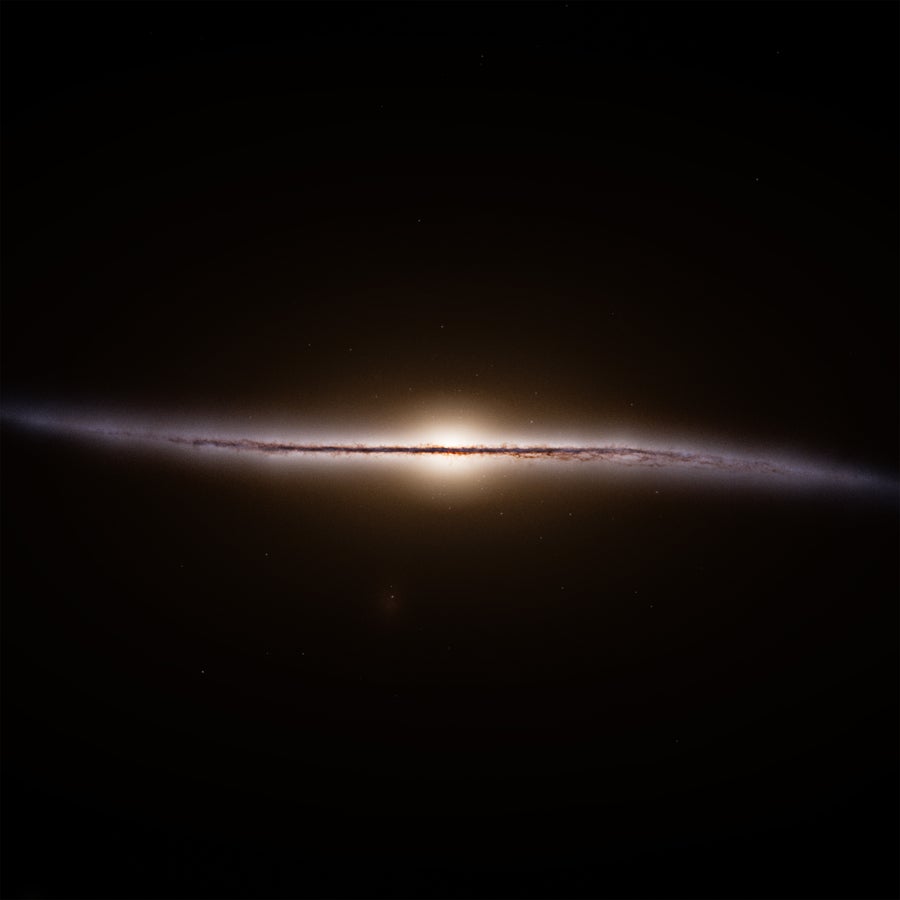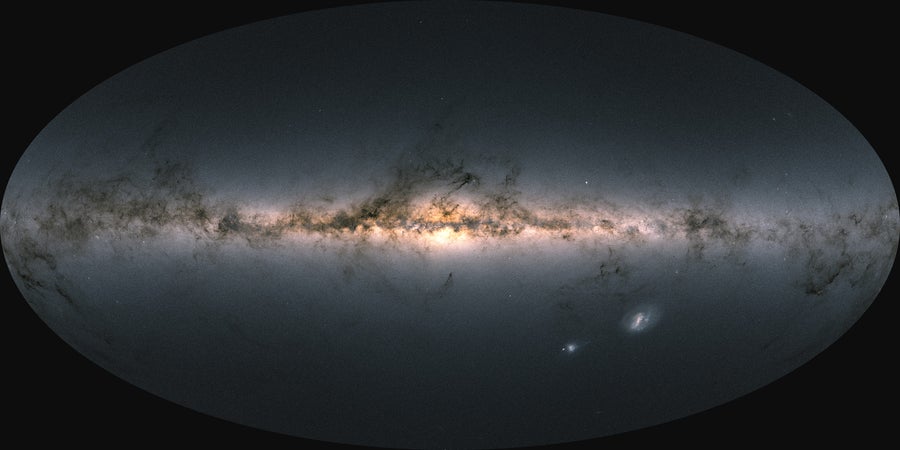This observatory has probably been the most transformative astronomy project of the 21st century, but there’s a good chance you’ve never heard of it. Just last week, for instance, the Hayden Planetarium at the American Museum of Natural History (AMNH) in New York City debuted a new “space show” called Encounters in the Milky Way—and this often overlooked spacecraft is its scientific superstar. But you’re more likely to know about actor Pedro Pascal’s narration in the show than you are to be familiar with the single space mission that serves as the presentation’s backbone.
The observatory is called Gaia. And, like so many good things, you wouldn’t really miss it until it’s gone—and now it is.
Launched in 2013 by the European Space Agency (ESA), it ceased operations this past March, when it used what little fuel it had left to steer into a graveyard orbit around the sun. From its station in a quiescent region of deep space more than 1.6 million kilometers from Earth, Gaia’s mission was, in essence, quite simple: it was designed to give us a better sense of where we are—a celestial “reference frame” on overlapping interplanetary, interstellar and intergalactic scales. To do that, it used twin sky-sweeping telescopes and three instruments, including a billion-pixel camera, to painstakingly measure the distances, positions, motions, and more of about two billion celestial objects, most of them stars in our own galaxy. It made some three trillion observations in all, producing (among many other things) the largest, most precise three-dimensional map of the Milky Way ever made.
On supporting science journalism
If you’re enjoying this article, consider supporting our award-winning journalism by subscribing. By purchasing a subscription you are helping to ensure the future of impactful stories about the discoveries and ideas shaping our world today.
“Gaia was our best galactic cartographer, and I sometimes say that Encounters in the Milky Way is my love letter to it,” says Jackie Faherty, a senior research scientist at the AMNH, who curated the new space show and regularly works with Gaia data. “It turns out you can learn a lot by determining where and how far off the stars are from you—and especially by how they are moving…. Gaia’s creation of this map is something we all should celebrate because it’s just as iconic and useful as the maps of Earth we all see in school or pull up on Google. Looking at it, you can find and explore all sorts of different things you want to know.”
From Gaia’s map, more than 13,000 peer-reviewed studies have already emerged, and many have concerned the fundamental structure and deep history of the Milky Way. Thanks to Gaia, scientists now can better gauge the amount of dark matter within our galaxy and have been able to track the Milky Way’s growth and evolution across eons via relic streams of stars strewn from ancient mergers with other, smaller galaxies.
“Stars retain memories of their origins in their ages, motions and chemical compositions—all of which Gaia measured,” says Amina Helmi, an astronomer at the Kapteyn Astronomical Institute in the Netherlands. She and her colleagues used the mission’s data to discover evidence of a major galactic merger that, some 10 billion years ago, shaped our home galaxy into the Milky Way we know today.
“With all that information, it was like a veil being lifted,” Helmi says. “We could suddenly perform what’s sometimes called ‘galactic archaeology,’ reconstructing the Milky Way’s history to see when and how this merger happened with another, smaller galaxy that was about a third to a quarter of our galaxy’s mass…. Gaia allows us to look billions of years into the Milky Way’s history—before our solar system even formed—to see what actually happened back then, which is absolutely amazing.”
Tracing perturbations from one more recent and ongoing merger, astronomers have even managed to reveal an apparent warp in the Milky Way’s disk, offering a new twist—literally—on the classic image of our cosmic home. At smaller scales, the spacecraft has refined the orbits of more than 150,000 asteroids, surveilling hundreds of them to see if they have their own moons. It has spied hints of thousands of worlds and even a few black holes orbiting other stars. At larger scales, it has helped estimate the expansion rate of the universe, and it has also teased out the subtle tugging of the Milky Way’s heart upon the solar system across tens of thousands of light-years.

Based on Gaia’s data, this artist’s impression shows our Milky Way galaxy from its side, highlighting an apparent warp in the galaxy’s starry disk.
Gaia’s sprawling cosmic reckoning is now a cornerstone for most state-of-the-art Earth- and space-based telescopes, which rely on the mission’s target-dense celestial map to orient and calibrate their own observations and operations. Whether it’s NASA’s James Webb Space Telescope, ESA’s Euclid mission, the ground-based, U.S.-built Vera C. Rubin Observatory or Europe’s under-construction Extremely Large Telescope, practically all of the world’s most exciting starlight-gathering telescopes will, in some sense, be guided by Gaia.
And stunningly, the best is yet to come. More than two thirds of the mission’s treasure trove of data is still under wraps. It is being prepared in a time-consuming process for two major upcoming milestones: about half of Gaia’s total data are targeted for release next year, and the mission’s full data are set to arrive no earlier than 2030.
But because it didn’t beam back images ready-made for lush wall posters and desktop backgrounds, Gaia was destined from the start to be “criminally under-recognized outside astronomy,” says Mark McCaughrean, an astronomer and former senior adviser to ESA. “And because Gaia provided utterly essential, if mundane, information such as precise stellar distances, it’s been doomed with this curse of simultaneous ubiquity and obscurity as many people use its data but take it for granted as just ‘coming from a catalog.’”
Anthony Brown, an astronomer at Leiden University in the Netherlands, who leads the mission’s data processing and analysis group, puts it most succinctly: “For astronomers, Gaia has become almost like the air you breathe,” he says.
At the heart of Gaia’s mapmaking is a technique called astrometry, the measurement of celestial positions and motions in the plane of the sky. Paired with a phenomenon called parallax—the apparent shift of an object’s position when viewed from two vantage points—astronomers can use Gaia for determining distances, too. You can see the parallax effect with your own two eyes: hold your thumb out at arm’s length and watch as it appears to jump around as you blink one eye and then the other. The closer the object is, the bigger its displacement will be. And the bigger your baseline is between two vantage points, the smaller the displacement will be that you can discern. Your eyes have a baseline of about six centimeters; Gaia’s was 300 million kilometers, set by the opposite sides of Earth’s orbit around the sun.
A Gaia predecessor, ESA’s Hipparcos mission, used that same gigantic baseline to survey the sky from 1989 until it ran out of fuel in 1993. But the technology of the time limited Hipparcos’s astrometric reckoning to a precision of about one milliarcsecond, with high-quality measurements only for about 100,000 objects within about 200 parsecs (650 light-years) of the solar system. (A single arc second is a very small angular slice of the heavens, making Hipparcos’s milliarcsecond precision all the more noteworthy. The moon, for instance, takes up about 1,800 arc seconds in Earth’s sky.)
As impressive as Hipparcos was, Gaia shattered the records set by its precursor—although not without challenges, such as precision-threatening sprays of stray light that leaked around the edges of the spacecraft’s sun shield and through a hole punched by an errant micrometeoroid. But ultimately, Brown says, Gaia’s measurements achieved on the order of 100 times greater precision—reaching about 10 microarcseconds. And within the Milky Way, the spacecraft’s view encompassed 100 times more volume and included 10 times more targets.

This map of the entire sky is based on Gaia’s data for the positions, brightness and color of more than 1.8 billion stars.
ESA/Gaia/DPAC; CC BY-SA 3.0 IGO; Acknowledgement: A. Moitinho (CC BY-SA 3.0 IGO)
The numbers underpinning Gaia are so alien to everyday experience that they border on nonsensical, says Michael Perryman, a former ESA researcher, who has served as project scientist for Hipparcos and Gaia and played a crucial developmental role for both missions. He likens Hipparcos’s precision to discerning a second’s worth of growth of a human hair from a distance of one meter. Gaia’s 100-times-better view, he says, is more like measuring the width of a single hydrogen atom from the same distance.
Another comparison involves the size of the two missions’ datasets. When the Hipparcos team printed out its complete catalog, Perryman recalls, it comprised five thick volumes—almost enough to fill a single shelf of a bookcase. Printing out the full Gaia catalog with the same density of information per page, he says, would require about 10 kilometers of shelf space.
“The mind boggles,” he says. “It’s almost incomprehensible; these are numbers and dimensions we’re simply not equipped to visualize, so even the analogies are very difficult to grasp.”
The best example of the heights such precision can reach may be Gaia’s tour de force determination of the solar system’s acceleration with respect to a vast, sky-encompassing field of quasars. Quasars are the conspicuously bright cores of remote galaxies that harbor actively feeding supermassive black holes. As such, quasars are among the most powerful beacons astronomers can use to probe distant regions of the universe. Gaia pinpointed the positions of more than one and a half million of them to establish a fixed backdrop of sorts, against which various minuscule motions of our solar system or other nearby celestial objects could be seen.
One motion Gaia managed to measure was an astonishingly small acceleration of just 0.232 nanometer per second squared—a continuous atom-scale deflection in the solar system’s 220-kilometer-per-second trajectory through the Milky Way, attributed to the gravitational pull from our galaxy’s center some 26,000 light-years away. Writ large, the displacement adds up to less than a meter per day—and essentially reflects the real-time sculpting of our galactic orbit as the solar system carves a path through the Milky Way’s gravitational field.
“It’s an almost circular motion around the galactic center, and it’s directed toward the supermassive black hole there,” says astronomer Sergei Klioner of Germany’s Dresden University of Technology, who led much of the work behind the measurement. “No other observational data could come anywhere close to competing with Gaia here…. You often hear the term ‘astronomical’ in the sense of something being very large—but this is an example where Gaia has shown us something that’s astronomically small.”
Now that Gaia has gone dark, there’s already talk of what comes next. “Do we really need another astrometry mission?” asks Brown, who first began working on Gaia in 1997. “Well, not immediately, but the extremely precise stellar reference frame it gave us—upon which many other observatories depend—will eventually deteriorate because all the stars are moving, right?” ESA is envisioning a follow-on mission, which would potential launching in the 2040s. This time that mission would be optimized for infrared observations to allow astronomers to see through the dust that otherwise clouds their view of the Milky Way’s star-packed disk and galactic center.
“It’s, in a way, wonderful but also a bit sad that people take Gaia for granted because, my God, it was a tough mission,” Perryman reflects. “I don’t feel sadness that it’s gone; I’m just delighted and relieved it lasted so long, and I’m very conscious of how remarkable it is that we live in a time when society is willing to pool its resources to support such things, and we have the technology in place to do them. I hope this period continues—but I worry we’ve been taking that for granted, too.”









